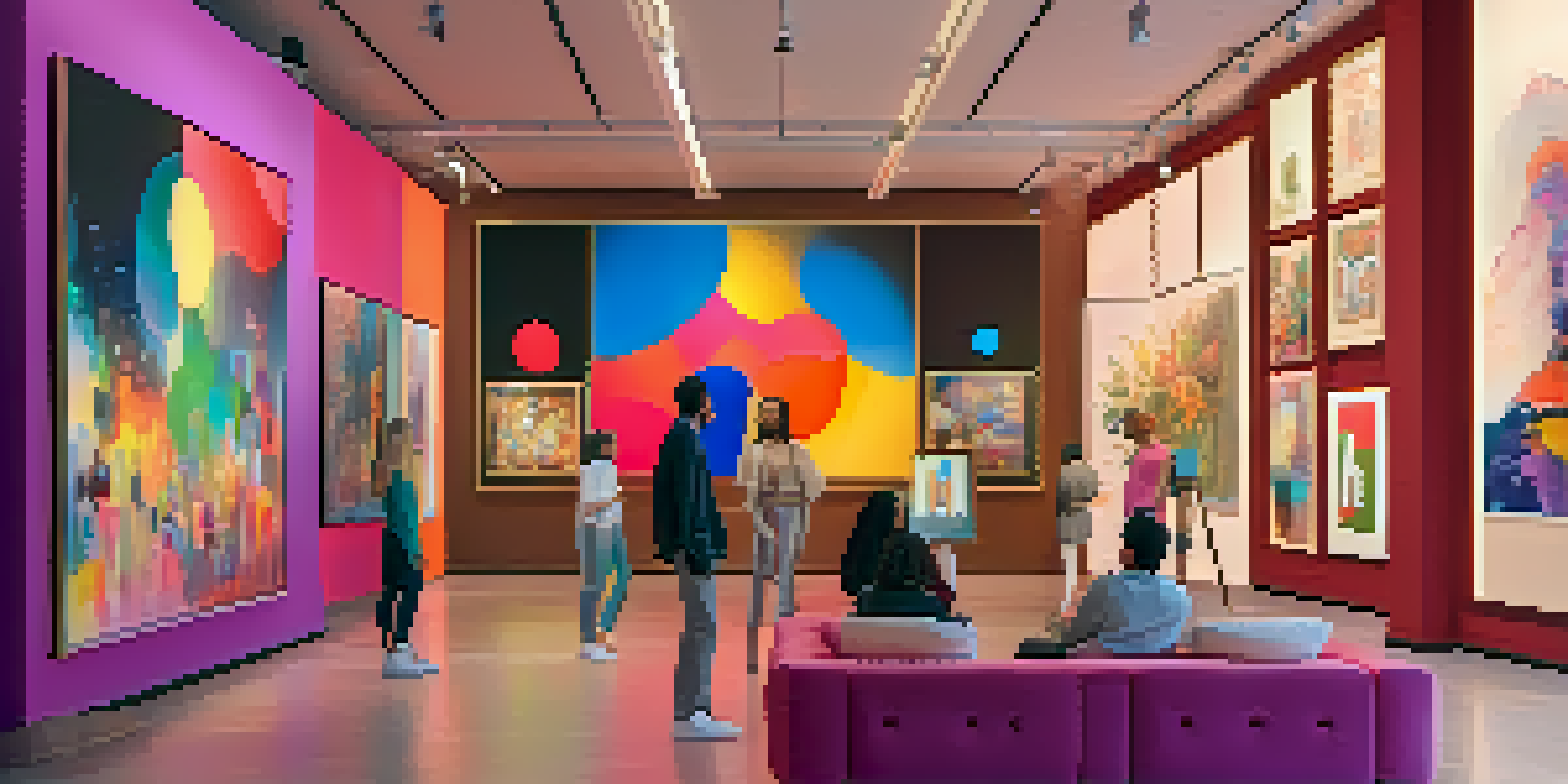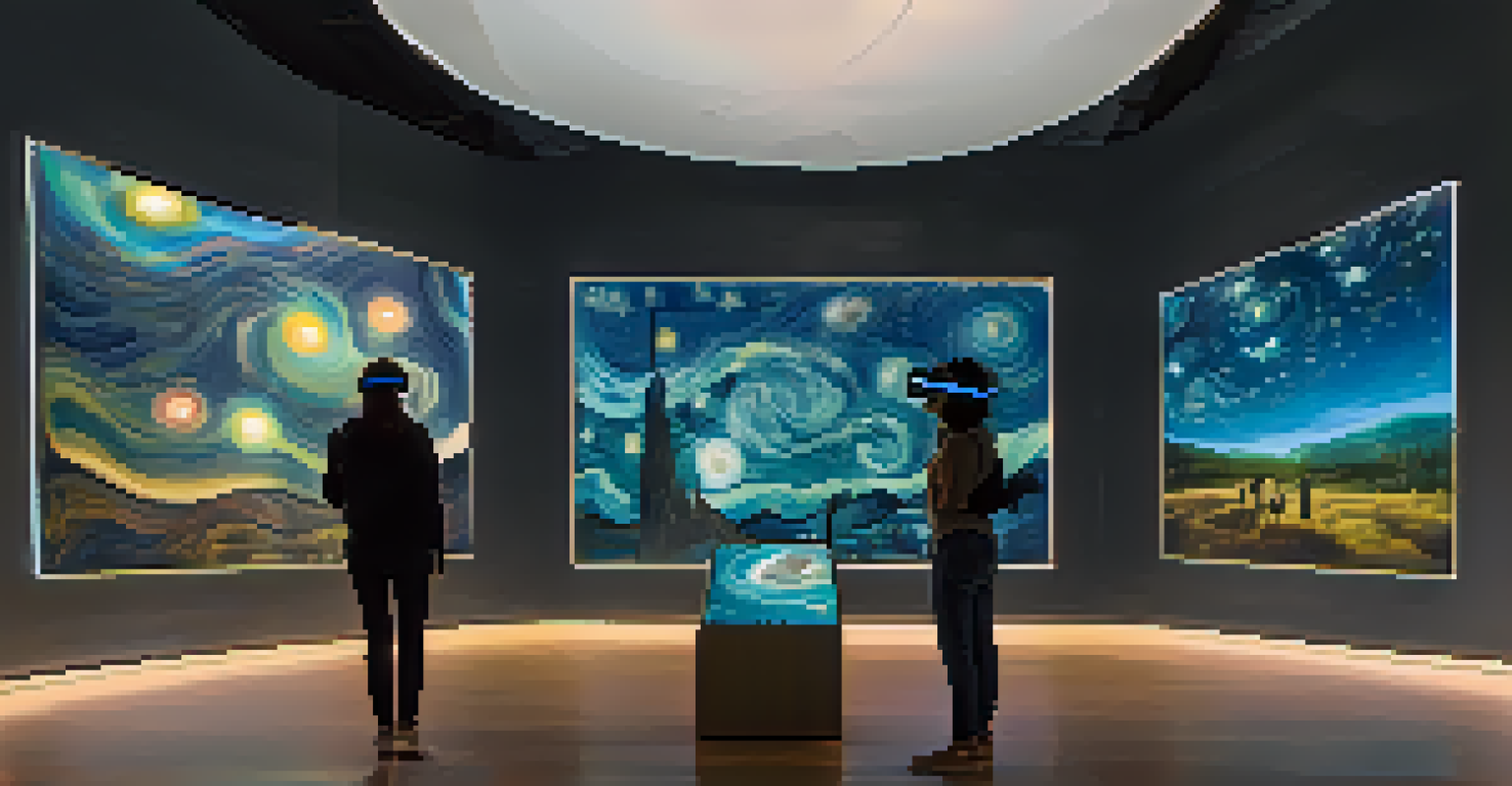How Ethereum Transformed Digital Art with NFT Technology

Understanding Ethereum and NFTs in Digital Art
Ethereum is a blockchain platform that enables developers to create decentralized applications, including non-fungible tokens (NFTs). NFTs are unique digital tokens that represent ownership of a specific item, often art, music, or collectibles. Unlike cryptocurrencies like Bitcoin, which are interchangeable, each NFT has distinct attributes, making them one-of-a-kind.
NFTs give artists the ability to directly connect with their audience, allowing them to sell their work without intermediaries.
The introduction of NFTs on the Ethereum blockchain has unlocked new possibilities for artists to monetize their work in the digital realm. By providing proof of authenticity and ownership, artists can sell their creations directly to collectors without the need for intermediaries. This shift empowers creators and fosters a more equitable art market.
As artists embrace this technology, they are finding innovative ways to express themselves and reach wider audiences. For instance, digital paintings or animations can now be sold as NFTs, allowing artists to retain control over their work and earn royalties on future sales. This transformation is reshaping the landscape of digital art.
The Rise of Digital Collectibles and Art Marketplaces
With the emergence of NFTs, a new wave of digital collectibles has taken the art world by storm. Platforms like OpenSea and Rarible serve as marketplaces where artists and collectors can buy, sell, and trade NFTs seamlessly. This democratization of the art market allows anyone with an internet connection to participate, breaking down traditional barriers.

Digital artists are now able to showcase their work to a global audience, gaining exposure that was previously difficult to achieve. Collectors, on the other hand, can discover unique pieces that resonate with them, often at prices that challenge the norms of the traditional art market. This shift is fostering a vibrant community around digital art.
NFTs Empower Digital Artists
Ethereum's NFT technology allows artists to sell their work directly to collectors, ensuring authenticity and ownership.
Moreover, the hype surrounding NFT collectibles has led to record-breaking sales, with some pieces fetching millions. This trend not only validates digital art as a legitimate form of expression but also encourages more creators to explore this medium. The excitement and possibilities are endless.
Empowering Artists Through Royalties and Ownership
One of the most significant benefits of NFTs for artists is the ability to earn royalties each time their artwork is resold. Smart contracts, a feature of Ethereum, embed these royalty terms directly into the NFT, ensuring that creators receive a percentage of future sales. This model is revolutionary in an industry where artists often lose out on profits after the initial sale.
The future of art is digital, and NFTs are the key to unlocking its potential.
For example, an artist selling a digital painting as an NFT might set a 10% royalty. If the buyer later resells the piece for a higher price, the original artist automatically receives 10% of that sale, creating a sustainable income stream. This system not only rewards artists financially but also incentivizes them to create more.
This shift in how artists can monetize their work is helping to foster a more sustainable creative ecosystem. No longer reliant solely on one-time sales or gallery exhibitions, artists can now cultivate ongoing relationships with collectors. This dynamic enhances the sense of community within the digital art space.
Challenges and Criticisms of NFT Technology
Despite the excitement surrounding NFTs, the technology isn't without its challenges and criticisms. One of the primary concerns is the environmental impact of blockchain technology, particularly with Ethereum's energy-intensive proof-of-work system. Critics argue that the carbon footprint associated with minting NFTs is unsustainable.
In response to these concerns, Ethereum is transitioning to a more eco-friendly proof-of-stake model, which promises to reduce energy consumption significantly. This shift reflects the community's awareness and willingness to address environmental issues while promoting digital art. However, it remains a contentious topic.
Community Drives NFT Success
Online platforms and social networks foster a supportive environment for artists and collectors, enhancing creativity and collaboration.
Additionally, the NFT space is rife with scams and copyright infringements, which can undermine the trust and integrity of the market. Artists need to be vigilant about protecting their work and verifying the legitimacy of platforms before engaging in transactions. As the industry matures, these challenges will require ongoing attention and solutions.
The Role of Community in the NFT Art World
Community plays a crucial role in the success of NFTs and digital art. Online forums, social media platforms, and Discord channels allow artists and collectors to connect, share ideas, and collaborate. This sense of belonging fosters creativity and innovation, making the digital art scene more dynamic.
Many artists credit their success to the support of their community, which often helps to promote their work and create buzz around new releases. This grassroots approach is empowering creators and proving that talent can shine through without the backing of traditional galleries or institutions.
Additionally, community-driven initiatives, such as NFT drops and collaborative projects, are becoming more common. These events not only provide artists with exposure but also encourage collectors to engage with the art in a meaningful way. The collaborative spirit enhances the overall experience of being part of the NFT art world.
Future Trends in Digital Art and NFTs
As technology continues to evolve, the future of digital art and NFTs looks promising. We are seeing a rise in augmented reality (AR) and virtual reality (VR) experiences that integrate with NFTs, allowing collectors to interact with art in new and exciting ways. Imagine walking through a virtual gallery filled with your NFT collection, experiencing each piece in an immersive environment.
Moreover, the concept of fractional ownership is gaining traction, enabling multiple collectors to own a share of a high-value NFT. This model allows more people to invest in expensive digital art, democratizing access to high-end pieces that were previously out of reach. It’s a fascinating development that could reshape how we view ownership in the art world.
Future Trends in Digital Art
Emerging technologies like AR and fractional ownership are poised to transform how we experience and invest in digital art.
As more artists explore the potential of NFTs, we can expect to see innovative forms of expression that challenge traditional boundaries. From generative art to interactive installations, the possibilities are endless. The digital art landscape is evolving rapidly, and it’s an exciting time to be part of this transformation.
Conclusion: The Lasting Impact of Ethereum on Digital Art
In conclusion, Ethereum's NFT technology has fundamentally transformed the digital art landscape, offering artists new avenues for expression and monetization. By providing proof of ownership and authenticity, NFTs empower creators while fostering a vibrant community of collectors and enthusiasts. This shift is not just a trend; it's reshaping the future of art.
While challenges remain, the ongoing evolution of this technology and the commitment to sustainability and community support signal a positive trajectory. As artists continue to push boundaries and explore new mediums, the art world will likely see unprecedented growth and innovation. The integration of NFTs into the art market is just the beginning.

Ultimately, Ethereum has ignited a revolution that invites us to rethink the value of art in the digital age. As we move forward, it's essential to embrace this change and support the artists who are shaping the future of creativity. The digital art landscape is a testament to the power of technology and community in redefining artistic expression.